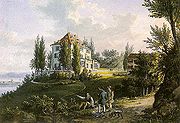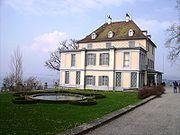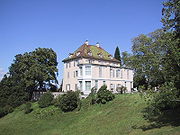
Arenenberg
Encyclopedia

Estate (house)
An estate comprises the houses and outbuildings and supporting farmland and woods that surround the gardens and grounds of a very large property, such as a country house or mansion. It is the modern term for a manor, but lacks the latter's now abolished jurisdictional authority...
with a small chateau
Château
A château is a manor house or residence of the lord of the manor or a country house of nobility or gentry, with or without fortifications, originally—and still most frequently—in French-speaking regions...
, Schloss Arenenberg, in the municipality
Municipalities of Switzerland
Communes , also known as municipalities, are the smallest government division in Switzerland, numbering 2,596 . While many have a population of a few hundred citizens, the largest cities such as Zürich or Geneva also have the legal status of municipalities...
of Salenstein
Salenstein
Salenstein is a municipality in Kreuzlingen District in the canton of Thurgau in Switzerland.Salenstein was the home village of Napoleon III, who lived at Castle Arenenberg in his youth.-History:...
at the shore of Lake Constance
Lake Constance
Lake Constance is a lake on the Rhine at the northern foot of the Alps, and consists of three bodies of water: the Obersee , the Untersee , and a connecting stretch of the Rhine, called the Seerhein.The lake is situated in Germany, Switzerland and Austria near the Alps...
in Thurgau
Thurgau
Thurgau is a northeast canton of Switzerland. The population, , is . In 2007, there were a total of 47,390 who were resident foreigners. The capital is Frauenfeld.-History:...
, Switzerland
Switzerland
Switzerland name of one of the Swiss cantons. ; ; ; or ), in its full name the Swiss Confederation , is a federal republic consisting of 26 cantons, with Bern as the seat of the federal authorities. The country is situated in Western Europe,Or Central Europe depending on the definition....
that is famous as the final domicile of Hortense de Beauharnais
Hortense de Beauharnais
Hortense Eugénie Cécile Bonaparte , Queen Consort of Holland, was the stepdaughter of Emperor Napoleon I, being the daughter of his first wife, Joséphine de Beauharnais. She later became the wife of the former's brother, Louis Bonaparte, King of Holland, and the mother of Napoleon III, Emperor of...
. Today it houses the Napoleonmuseum. It is a Swiss heritage site of national significance
Swiss Inventory of Cultural Property of National and Regional Significance
The Swiss Inventory of Cultural Property of National and Regional Significance is a register of some 8,300 items of cultural property in Switzerland...
.
History
Arenenberg was built in the early 16th century by the mayor of ConstanceConstance
Constance is a female given name that derives from Latin and means "constant." Variations of the name include Connie, Constancia, Constanze, Constanza, Stanzy, and Konstanze.Constance may refer to:-People:*Constance Bennett , American actress...
(1546 -1548) Sebastian Geissberg. The name of the farm that had been located there before was Narrenberg ("fools' mountain"), perhaps not a suitable name to hold on to, but also the hill towards the lake was named "Arnhalde". By the 19th century the current name was used.
The estate saw a number of owners. In 1817, Johann Baptist von Streng sold it to the exiled Hortense de Beauharnais, the daughter of ex-Empress Joséphine
Joséphine de Beauharnais
Joséphine de Beauharnais was the first wife of Napoléon Bonaparte, and thus the first Empress of the French. Her first husband Alexandre de Beauharnais had been guillotined during the Reign of Terror, and she had been imprisoned in the Carmes prison until her release five days after Alexandre's...
, for 30.000 guilders. As arranged by Napoleon, Hortense had to marry his brother Louis Bonaparte
Louis Bonaparte
Louis Napoléon Bonaparte, Prince Français, Comte de Saint-Leu , King of Holland , was the fifth surviving child and the fourth surviving son of Carlo Buonaparte and Letizia Ramolino...
, and the couple were named King and Queen of the Netherlands
Kingdom of the Netherlands
The Kingdom of the Netherlands is a sovereign state and constitutional monarchy with territory in Western Europe and in the Caribbean. The four parts of the Kingdom—Aruba, Curaçao, the Netherlands, and Sint Maarten—are referred to as "countries", and participate on a basis of equality...
(1806 to 1810). The royal couple not only suffered with the demise of the rule of Napoleon, but also had an unhappy marriage leading to a separation. Hortense initiated reconstructions and renovations in an attempt to recreate the atmosphere of Malmaison
Château de Malmaison
The Château de Malmaison is a country house in the city of Rueil-Malmaison about 12 km from Paris.It was formerly the residence of Joséphine de Beauharnais, and with the Tuileries, was from 1800 to 1802 the headquarters of the French government.-History:Joséphine de Beauharnais bought the...
. The surrounding park was possibly designed by Louis-Martin Berthault. In 1818 she moved in. Her brother, Eugène de Beauharnais
Eugène de Beauharnais
Eugène Rose de Beauharnais, Prince Français, Prince of Venice, Viceroy of the Kingdom of Italy, Hereditary Grand Duke of Frankfurt, 1st Duke of Leuchtenberg and 1st Prince of Eichstätt ad personam was the first child and only son of Alexandre, Vicomte de Beauharnais and Joséphine Tascher de la...
, bought the nearby Schloss Sandegg and built a villa close by.

Augsburg
Augsburg is a city in the south-west of Bavaria, Germany. It is a university town and home of the Regierungsbezirk Schwaben and the Bezirk Schwaben. Augsburg is an urban district and home to the institutions of the Landkreis Augsburg. It is, as of 2008, the third-largest city in Bavaria with a...
, Arenenberg soon became her main domicile. At her Parisian-styled salon
Salon (gathering)
A salon is a gathering of people under the roof of an inspiring host, held partly to amuse one another and partly to refine taste and increase their knowledge of the participants through conversation. These gatherings often consciously followed Horace's definition of the aims of poetry, "either to...
she entertained many luminaries. Her son Louis Napoléon, the future emperor Napoléon III, who had attended school in Augsburg, visited Arenenberg as a teenager; there he was further educated and then attended the Swiss military academy at Thun
Thun
Thun is a municipality in the administrative district of Thun in the canton of Bern in Switzerland with about 42,136 inhabitants , as of 1 January 2006....
, receiving Swiss citizenship. In 1837, while he was exiled and living in New York City
New York City
New York is the most populous city in the United States and the center of the New York Metropolitan Area, one of the most populous metropolitan areas in the world. New York exerts a significant impact upon global commerce, finance, media, art, fashion, research, technology, education, and...
, Louis Napoleon received notice of his mother's deteriorating health and returned to Arenenberg. Hortense died on 5 October 1837. After mourning, Louis Napoleon had to leave Switzerland, due to French pressure, and moved to London. In 1843, in need of money to finance his aspirations, he sold the property to Heinrich Keller. Once he was emperor, his empress Eugénie
Eugénie de Montijo
Doña María Eugenia Ignacia Augustina de Palafox-Portocarrero de Guzmán y Kirkpatrick, 16th Countess of Teba and 15th Marquise of Ardales; 5 May 1826 – 11 July 1920), known as Eugénie de Montijo , was the last Empress consort of the French from 1853 to 1871 as the wife of Napoleon III, Emperor of...
bought it back in 1855. Further renovations were made between 1855 and 1874.

Today the château is home to the Napoleon Museum. The Napoleon Park is being restored.
Literature
- Johannes Meyer, Die früheren Besitzer von Arenenberg. Frauenfeld 1920
- Jakob Hugentobler, Die Familie Bonaparte auf Arenenberg. Salenstein 1989
- Dominik Gügel and Christina Egli: Arkadien am Bodensee. Europäische Gartenkultur des beginnenden 19. Jahrhunderts. Frauenfeld 2005.

